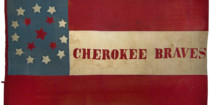Fight for Survival.
Currently in its second season, the PBS series Mercy Street is a period medical drama that explores hospital life and patient care during the Civil War. Inspired by real people and events, Mercy Street goes beyond the front lines of the Civil War and into the chaotic world of the Mansion House Hospital in Union-occupied Alexandria, Virginia. If you are interested in learning more about Civil War medicine, below you can find some curated resources describing field medical practices and treatment in general. We have also included some exclusive information about medicine at the Battle of Wilson’s Creek, as well as resources available at Wilson’s Creek National Battlefield.
Medicine
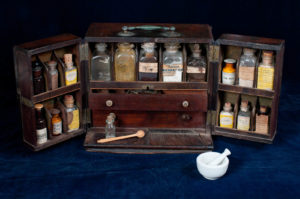
- Did you know 19th century medicine wasn’t always crude or ineffective? The biggest problem was not being prepared. Thomas Sweeney, a retired physician, offers some fascinating insight on medicine during the Civil War.
- Hospital facilities were radically different at the end of the war than at the beginning. This collection of resources from the University of Toledo covers the sheer brutality and lessons learned.
- The progression of American medical practices was greatly advanced during this time. Learn about how the ambulance system began and who founded the Red Cross.
Surgery
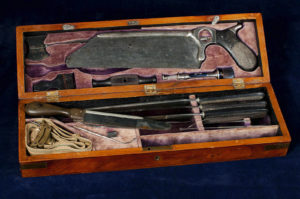
- Surgery looked quite a bit different 150 years ago. Saws, knives and sharp hooks were the tools of the trade. Most wounds became infected and limbs had to be amputated. Want to learn more?
- 70 percent of all wounds were to the extremities. By the end of the war, an estimated 60,000 amputations were performed on both sides. This photo essay shows these staggering statistics and much more.
Medicine at Wilson’s Creek
 Just before the break of dawn on August 10, the Battle of Wilson’s Creek commenced. Before noon there would be 1,818 wounded and 535 dead. The physicians of both armies began the urgent process to gather, treat, and evacuate the wounded. Many of the wounded had to find their way to wherever the surgeons had established their medical facilities. In some areas there were aid or dressing stations where the wounded were given a cursory examination and stabilized. Blood flow was stanched, broken bones immobilized, and stimulants given to counteract shock. They were brought from these stations or went directly to field hospitals where further treatment was given. The surgeons of the southern forces established their own field hospitals locate at various sites about the battlefield. Here major surgery was performed while the battle raged around them. With the fighting in Ray’s cornfield reaching its climax, Confederate medical officers commandeered the nearby Ray house, shown here, for the care and treatment of the wounded.
Just before the break of dawn on August 10, the Battle of Wilson’s Creek commenced. Before noon there would be 1,818 wounded and 535 dead. The physicians of both armies began the urgent process to gather, treat, and evacuate the wounded. Many of the wounded had to find their way to wherever the surgeons had established their medical facilities. In some areas there were aid or dressing stations where the wounded were given a cursory examination and stabilized. Blood flow was stanched, broken bones immobilized, and stimulants given to counteract shock. They were brought from these stations or went directly to field hospitals where further treatment was given. The surgeons of the southern forces established their own field hospitals locate at various sites about the battlefield. Here major surgery was performed while the battle raged around them. With the fighting in Ray’s cornfield reaching its climax, Confederate medical officers commandeered the nearby Ray house, shown here, for the care and treatment of the wounded.
–From A Scene of Horrors by Kip Lindberg and Thomas P. Sweeney, MD. More information about field medicine and hospitals can be found here.
Fighting for Survival
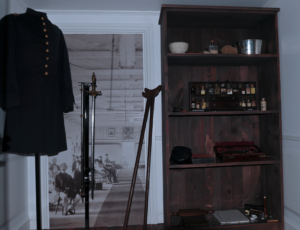 Wilson’s Creek National Battlefield has a new exhibit designed to educate visitors about the importance of medicine during the Civil War. Just like in all wars, major advancements in medicine occurred between 1861 and 1865. Two discoveries that we now take for granted were the use of anesthesia, both ether and chloroform, and the development of artificial limbs. Artificial limbs were necessary due to the large number of amputations during the Civil War.
Wilson’s Creek National Battlefield has a new exhibit designed to educate visitors about the importance of medicine during the Civil War. Just like in all wars, major advancements in medicine occurred between 1861 and 1865. Two discoveries that we now take for granted were the use of anesthesia, both ether and chloroform, and the development of artificial limbs. Artificial limbs were necessary due to the large number of amputations during the Civil War.
This new exhibit allows visitors the opportunity to see medical equipment of the time, like a blood lancet, scarificator (a device used for blood-letting, a common practice of the time), syringe, forceps, bleeding cup, cupping glass, and apothecary chest, as well as other items used by medical officers during the Civil War. Also on display are an amputation kit belonging to Confederate Surgeon Edward H. C. Bailey and a medical frock coat and officer’s sword worn by John F. Brothers of the 8th Missouri Cavalry. Find more information about these items and other topics related to Civil War medicine.
Want to Learn More?
A Scene of Horrors
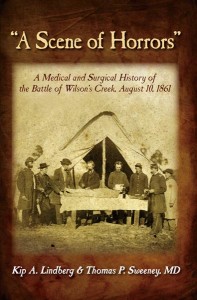
This is the first book to cover the care and treatment of the men who engaged in the opening battles of the Civil War in Missouri, culminating in the Battle of Wilson’s Creek. Using period accounts, official records, photographs, and post war recollections, Lindburg and Sweeney, M.D., tell the stories of the physicians charged with the care of the soldiers of both sides, their training, education, and experience.
Portraits of Conflict

The extensive text accompanying the photographs includes a chapter, “Civil War Medicine in Missouri,” that is the only comprehensive history of the topic written to date. It describes the evolution of military medical care in Missouri from its haphazard beginnings to its development into a large-scale, well-organized service that attracted the attention and envy of medical specialists in Europe.



